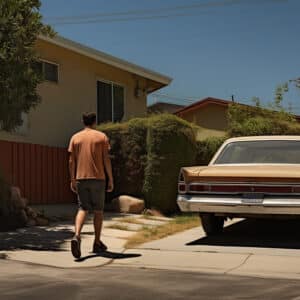If I Have an Accident in Someone Else’s Car, Will My Insurance Cover It?
Last updated Wednesday, February 19th, 2025

If I have an accident in someone else’s car, will my insurance cover it? It’s a pressing question for any driver in this situation. This article tackles the crux of whether your policy will come into play, guiding you through primary and secondary coverage, permission nuances, and factors that determine your insurance’s role after such accidents.
Key Takeaways
- If you have an accident while driving someone else’s car, the car owner’s insurance typically serves as primary coverage while your insurance may provide secondary coverage after the primary limits are exceeded.
- The permission to drive another’s car, whether explicit or implied, greatly influences the insurance coverage, with non-permissive use potentially leading to the driver’s insurance being the primary coverage and legal consequences.
- Accidents in borrowed vehicles can impact your auto insurance rates, with potential increases due to risk assessment by insurers, and could affect your long-term insurance record and premiums.
Understanding Your Coverage in Another’s Vehicle
Driving someone else’s car can complicate insurance matters. It’s not always clear whether your insurance or the car owner’s insurance would provide coverage in case of an accident. To navigate these murky waters, it’s important to understand the concept of primary and secondary coverage.
We’ll further examine this complex issue.
Primary vs. Secondary Coverage
Primary coverage is essentially the main line of defense in case of an accident. It’s usually provided by the car owner’s insurance. However, what if the primary coverage isn’t enough to cover the damages? That’s where secondary coverage comes into play.
If you’re driving someone else’s car and get into an accident, your insurance policy may act as secondary coverage, covering the remaining costs after the primary coverage has been exhausted.
The Role of Collision Coverage and Liability
Moving on, we’ll discuss collision coverage and liability. Collision coverage, as the name suggests, helps cover the costs of repairing or replacing the vehicle involved in an accident, irrespective of who is at fault.
On the other hand, if you’re deemed responsible for the accident, liability coverage kicks in and covers damages to another person’s property or injuries. So, if you’re driving a borrowed car and get into an accident, the owner’s collision coverage might cover the damages to the vehicle, and your liability insurance might cover the remaining costs.
Non-Owned Vehicle Insurance Explained
Then there’s non-owned motor vehicle insurance. This is a special type of insurance that offers liability coverage for injuries or damages resulting from the operation of someone else’s car, not owned by the driver, or her own insurance.
So, if you frequently borrow or rent cars, having non-owned vehicle car insurance can provide you additional protection.
Permission to Drive: A Key Factor
We’ve covered various types of insurances thus far, but there’s one key factor that significantly impacts insurance coverage when driving someone else’s car: permission. Whether you’ve been given explicit consent to drive or there’s an implied permission based on past behavior can make a big difference in how insurance claims are handled.
Implied Permission Scenarios
Implied permission scenarios are a bit tricky. These are situations where the car owner hasn’t explicitly given you permission to drive, but based on your relationship or past conduct, permission is assumed.
For example, if you have a history of borrowing your friend’s car and they’ve never objected, this could be seen as implied permission.
Explicit Consent and Coverage
On the other hand, explicit consent is when the car owner has clearly given you permission to drive the car. This can greatly simplify insurance matters. If an accident happens while you’re driving with explicit consent, the owner’s insurance may cover the resulting damages.
When the Borrower’s Policy Comes Into Play
Next, we’ll look into situations where the borrower’s insurance policy might be applied. What happens if the car owner’s policy limits are reached? Would the borrower’s policy cover the remaining costs? Let’s find out.
Exhausting Policy Limits
Imagine this: You’re driving your friend’s car, and you get into a serious accident. The repair costs and medical bills are high, and they exceed your friend’s policy limits. In this situation, your insurance could come to the rescue, working alongside your friend’s insurance company.
If the car owner’s auto insurance policy limits are reached, your car insurance coverage may provide additional coverage to meet the remaining costs.
Understanding Subrogation
You might question how insurance companies recoup the costs they’ve paid out for an accident. The answer lies in a process known as subrogation. In subrogation, an insurance company seeks reimbursement from another insurer for a claim it has paid.
This process is usually initiated by the insurer that paid the claim sending a subrogation letter to the other insurance company and the at-fault party.
Handling Accidents Without Owner’s Permission
But what if you’re driving someone else’s car without their permission and you get into an accident? How are such cases
We’ll examine this situation more closely.
Non-Permissive Use and Legal Consequences
Accidents that occur due to non-permissive use of a vehicle can result in serious legal consequences. If you take someone’s car without their consent and cause an accident, it could be considered theft. In such cases, the unauthorized driver’s insurance may act as the primary coverage. However, if the driver does not have insurance, the car owner may need to file a claim with their own insurance company.
Dealing with Insurance Claims
Insurance claims in instances of non-permissive use can be rather intricate. It’s crucial to report the accident promptly to the relevant insurance company and provide all the necessary details. Failure to do so could lead to denial of claims and potential legal issues.
Potential Impact on Your Auto Insurance Rates
Moving forward, we’ll consider how an incident in another person’s vehicle could influence your auto insurance premiums. If you’re deemed at fault, the accident could potentially result in an increase in your auto insurance rates when it comes time for renewal.
Rate Increases and Risk Assessment
Insurance companies assess risk based on a number of factors, including your driving history and the severity of the accident. If you’re involved in an accident while driving someone else’s car, the insurance company may view you as a higher risk, leading to an increase in your rates.
Long-Term Insurance Record Considerations
It’s also important to consider the long-term implications of an accident on your insurance record. An accident could stay on your record for three to five years, potentially affecting your future rates and coverage options.
Protecting Yourself Before Driving Another’s Vehicle
Having covered potential complications, we’ll now discuss ways to safeguard yourself prior to driving someone else’s vehicle. This involves verifying insurance details and having a clear understanding with the car owner.
Verifying Insurance Details
Before you get behind the wheel, confirm whether your driver’s insurance policy provides coverage in case of an accident and if you, as a licensed driver, are included as an insured driver on the car owner’s policy. Ask the car owner to provide proof of insurance and ensure that their coverage is up-to-date.
Discussing with the Car Owner
Having a clear understanding with the car owner about your permission to drive their car and any potential liabilities is also important. Discuss the terms of use and any potential consequences in the event of an accident. This can help prevent misunderstandings later.
Navigating the Claims Process
Should a car accident happen while you’re operating another person’s car, you’ll have to manage the claims process. This involves filing a police report and communicating with insurance companies.
Filing a Police Report
Filing a police report is a crucial step in documenting the accident and providing necessary information for insurance claims. Ensure that you provide all the relevant details, including the date, time, and location of the accident, as well as any other important information about the incident.
Communication with Insurance Companies
Maintain open communication with both your own and the car owner’s insurance companies to ensure a smooth claims process. This includes promptly reporting the claim, engaging with the claims adjuster, and meticulously recording all communications.
Legal Considerations After an Accident
Post-accident, there are potential legal implications to consider. This includes determining liability and protecting your
Determining Liability
Determining liability can be complex, especially when driving someone else’s car. Liability is determined based on a range of factors, including the circumstances of the accident and the established duty of care. In some cases, you might need to seek legal assistance to determine liability.
Personal Assets at Risk
If your insurance coverage is insufficient to cover the damages and injuries resulting from an accident, your personal assets may be at risk, including potential medical expenses. This could include:
- Funds in checking and savings accounts
- Income from employment
- Home ownership
- Stocks and bonds
- Inheritance
It’s crucial to understand these risks and take necessary measures to protect your assets.
Frequently Asked Questions
How does insurance work when using someone else's car?
In most cases, auto insurance coverage follows the car, meaning it comes from the vehicle’s owner. If you’re listed on the owner’s insurance policy, you’ll be covered when driving the car. If not, coverage will depend on consent.
What happens when you wreck someone else's car?
The owner of the vehicle would need to file a claim with their insurance to cover any damages, as car insurance generally follows the vehicle, not the driver. Exceptions to this rule exist.
What is primary coverage in auto insurance?
In auto insurance, primary coverage is the initial coverage applied to address claims for damage and medical expenses, regardless of any other coverage the policyholder may have.
What is implied permission in auto insurance?
Implied permission in auto insurance refers to the inferred authorization to operate a vehicle, even without explicit permission from the owner.
What happens if the car owner's policy limits are reached?
When the car owner’s policy limits are reached, the borrower’s insurance may offer additional coverage for the remaining costs. Therefore, the borrower’s insurance can help cover the remaining expenses once the car owner’s policy limits are reached.










